Comprehensive Report on Business Operations: Structure, Accounting, HR
VerifiedAdded on 2021/01/03
|9
|2389
|379
Report
AI Summary
This report provides a comprehensive overview of business operations, encompassing various aspects such as organizational structures, the impact of the business environment, and the significance of accounting in financial management. It delves into the crucial functions of the HR department, including staffing, training, and compliance with employment legislation. The report also examines the interpretation of profit and loss accounts, the roles of team leaders and members, and the stages of team development. Furthermore, it explores motivational theories, different leadership styles, and the impact of consumer service and profiling on business success. The report concludes by summarizing key findings and emphasizing the interconnectedness of these elements in driving business performance. The report also includes references to support the information presented.
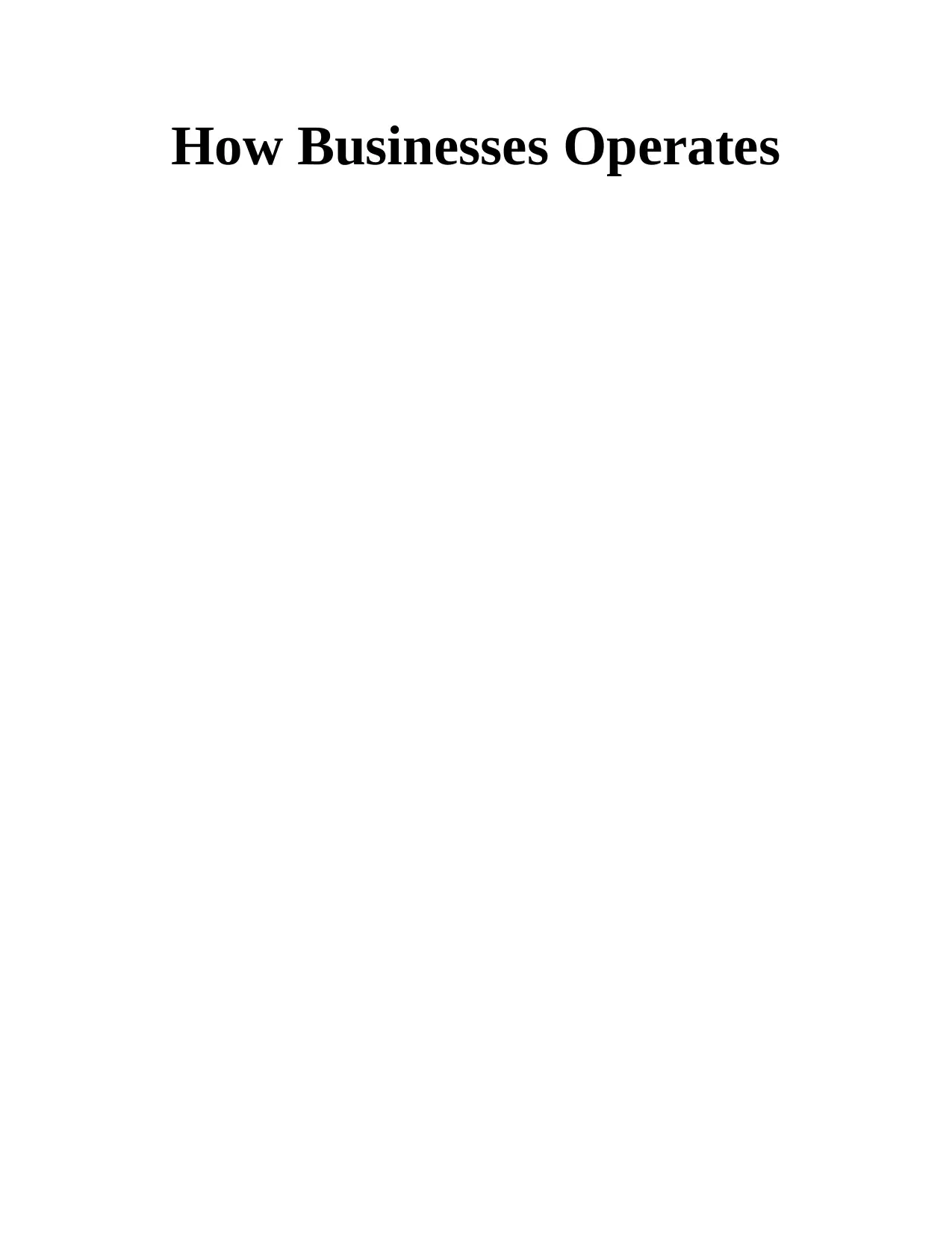
How Businesses Operates
Paraphrase This Document
Need a fresh take? Get an instant paraphrase of this document with our AI Paraphraser
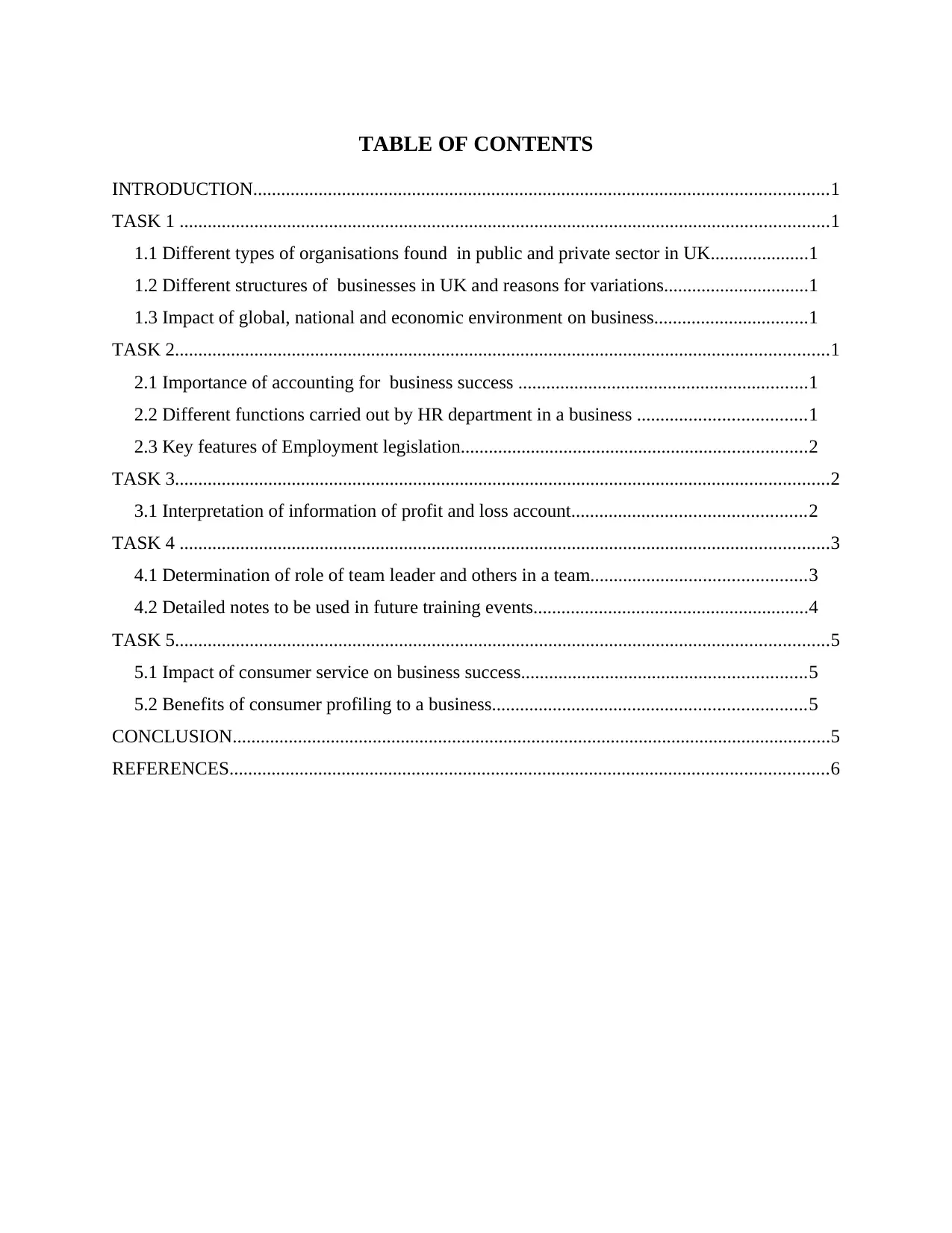
TABLE OF CONTENTS
INTRODUCTION...........................................................................................................................1
TASK 1 ...........................................................................................................................................1
1.1 Different types of organisations found in public and private sector in UK.....................1
1.2 Different structures of businesses in UK and reasons for variations...............................1
1.3 Impact of global, national and economic environment on business.................................1
TASK 2............................................................................................................................................1
2.1 Importance of accounting for business success ..............................................................1
2.2 Different functions carried out by HR department in a business ....................................1
2.3 Key features of Employment legislation..........................................................................2
TASK 3............................................................................................................................................2
3.1 Interpretation of information of profit and loss account..................................................2
TASK 4 ...........................................................................................................................................3
4.1 Determination of role of team leader and others in a team..............................................3
4.2 Detailed notes to be used in future training events...........................................................4
TASK 5............................................................................................................................................5
5.1 Impact of consumer service on business success.............................................................5
5.2 Benefits of consumer profiling to a business...................................................................5
CONCLUSION................................................................................................................................5
REFERENCES................................................................................................................................6
INTRODUCTION...........................................................................................................................1
TASK 1 ...........................................................................................................................................1
1.1 Different types of organisations found in public and private sector in UK.....................1
1.2 Different structures of businesses in UK and reasons for variations...............................1
1.3 Impact of global, national and economic environment on business.................................1
TASK 2............................................................................................................................................1
2.1 Importance of accounting for business success ..............................................................1
2.2 Different functions carried out by HR department in a business ....................................1
2.3 Key features of Employment legislation..........................................................................2
TASK 3............................................................................................................................................2
3.1 Interpretation of information of profit and loss account..................................................2
TASK 4 ...........................................................................................................................................3
4.1 Determination of role of team leader and others in a team..............................................3
4.2 Detailed notes to be used in future training events...........................................................4
TASK 5............................................................................................................................................5
5.1 Impact of consumer service on business success.............................................................5
5.2 Benefits of consumer profiling to a business...................................................................5
CONCLUSION................................................................................................................................5
REFERENCES................................................................................................................................6
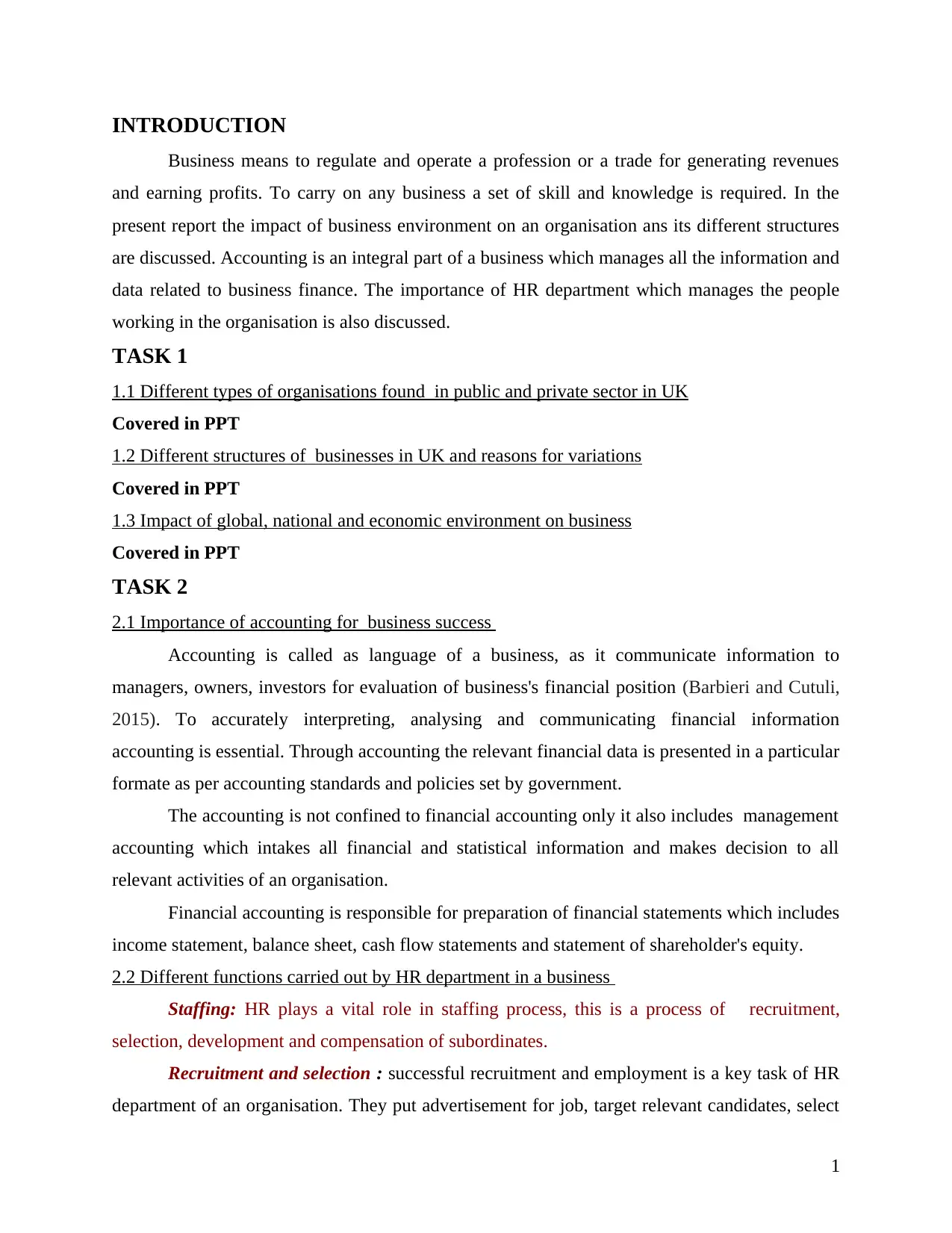
INTRODUCTION
Business means to regulate and operate a profession or a trade for generating revenues
and earning profits. To carry on any business a set of skill and knowledge is required. In the
present report the impact of business environment on an organisation ans its different structures
are discussed. Accounting is an integral part of a business which manages all the information and
data related to business finance. The importance of HR department which manages the people
working in the organisation is also discussed.
TASK 1
1.1 Different types of organisations found in public and private sector in UK
Covered in PPT
1.2 Different structures of businesses in UK and reasons for variations
Covered in PPT
1.3 Impact of global, national and economic environment on business
Covered in PPT
TASK 2
2.1 Importance of accounting for business success
Accounting is called as language of a business, as it communicate information to
managers, owners, investors for evaluation of business's financial position (Barbieri and Cutuli,
2015). To accurately interpreting, analysing and communicating financial information
accounting is essential. Through accounting the relevant financial data is presented in a particular
formate as per accounting standards and policies set by government.
The accounting is not confined to financial accounting only it also includes management
accounting which intakes all financial and statistical information and makes decision to all
relevant activities of an organisation.
Financial accounting is responsible for preparation of financial statements which includes
income statement, balance sheet, cash flow statements and statement of shareholder's equity.
2.2 Different functions carried out by HR department in a business
Staffing: HR plays a vital role in staffing process, this is a process of recruitment,
selection, development and compensation of subordinates.
Recruitment and selection : successful recruitment and employment is a key task of HR
department of an organisation. They put advertisement for job, target relevant candidates, select
1
Business means to regulate and operate a profession or a trade for generating revenues
and earning profits. To carry on any business a set of skill and knowledge is required. In the
present report the impact of business environment on an organisation ans its different structures
are discussed. Accounting is an integral part of a business which manages all the information and
data related to business finance. The importance of HR department which manages the people
working in the organisation is also discussed.
TASK 1
1.1 Different types of organisations found in public and private sector in UK
Covered in PPT
1.2 Different structures of businesses in UK and reasons for variations
Covered in PPT
1.3 Impact of global, national and economic environment on business
Covered in PPT
TASK 2
2.1 Importance of accounting for business success
Accounting is called as language of a business, as it communicate information to
managers, owners, investors for evaluation of business's financial position (Barbieri and Cutuli,
2015). To accurately interpreting, analysing and communicating financial information
accounting is essential. Through accounting the relevant financial data is presented in a particular
formate as per accounting standards and policies set by government.
The accounting is not confined to financial accounting only it also includes management
accounting which intakes all financial and statistical information and makes decision to all
relevant activities of an organisation.
Financial accounting is responsible for preparation of financial statements which includes
income statement, balance sheet, cash flow statements and statement of shareholder's equity.
2.2 Different functions carried out by HR department in a business
Staffing: HR plays a vital role in staffing process, this is a process of recruitment,
selection, development and compensation of subordinates.
Recruitment and selection : successful recruitment and employment is a key task of HR
department of an organisation. They put advertisement for job, target relevant candidates, select
1
⊘ This is a preview!⊘
Do you want full access?
Subscribe today to unlock all pages.

Trusted by 1+ million students worldwide
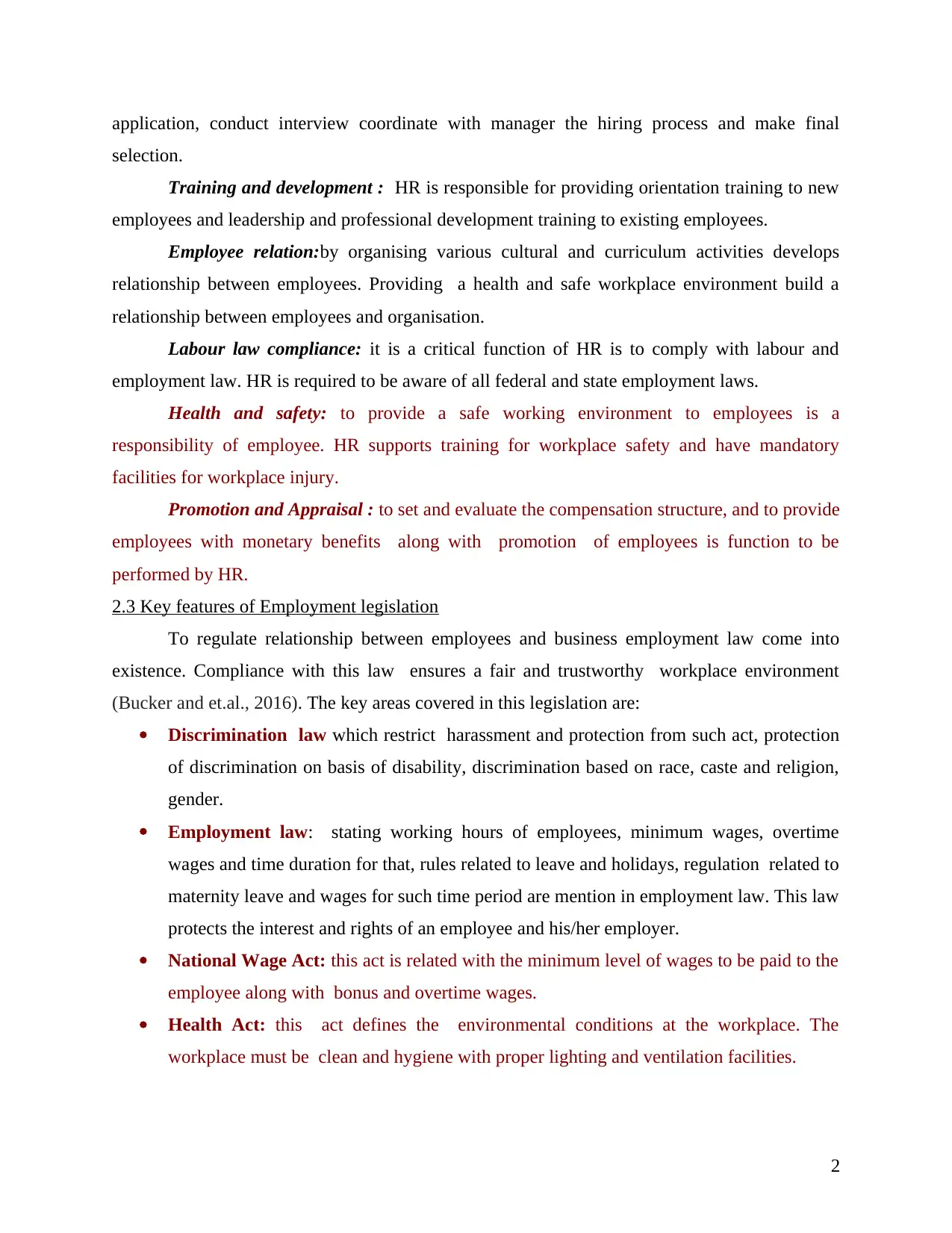
application, conduct interview coordinate with manager the hiring process and make final
selection.
Training and development : HR is responsible for providing orientation training to new
employees and leadership and professional development training to existing employees.
Employee relation:by organising various cultural and curriculum activities develops
relationship between employees. Providing a health and safe workplace environment build a
relationship between employees and organisation.
Labour law compliance: it is a critical function of HR is to comply with labour and
employment law. HR is required to be aware of all federal and state employment laws.
Health and safety: to provide a safe working environment to employees is a
responsibility of employee. HR supports training for workplace safety and have mandatory
facilities for workplace injury.
Promotion and Appraisal : to set and evaluate the compensation structure, and to provide
employees with monetary benefits along with promotion of employees is function to be
performed by HR.
2.3 Key features of Employment legislation
To regulate relationship between employees and business employment law come into
existence. Compliance with this law ensures a fair and trustworthy workplace environment
(Bucker and et.al., 2016). The key areas covered in this legislation are:
Discrimination law which restrict harassment and protection from such act, protection
of discrimination on basis of disability, discrimination based on race, caste and religion,
gender.
Employment law: stating working hours of employees, minimum wages, overtime
wages and time duration for that, rules related to leave and holidays, regulation related to
maternity leave and wages for such time period are mention in employment law. This law
protects the interest and rights of an employee and his/her employer.
National Wage Act: this act is related with the minimum level of wages to be paid to the
employee along with bonus and overtime wages.
Health Act: this act defines the environmental conditions at the workplace. The
workplace must be clean and hygiene with proper lighting and ventilation facilities.
2
selection.
Training and development : HR is responsible for providing orientation training to new
employees and leadership and professional development training to existing employees.
Employee relation:by organising various cultural and curriculum activities develops
relationship between employees. Providing a health and safe workplace environment build a
relationship between employees and organisation.
Labour law compliance: it is a critical function of HR is to comply with labour and
employment law. HR is required to be aware of all federal and state employment laws.
Health and safety: to provide a safe working environment to employees is a
responsibility of employee. HR supports training for workplace safety and have mandatory
facilities for workplace injury.
Promotion and Appraisal : to set and evaluate the compensation structure, and to provide
employees with monetary benefits along with promotion of employees is function to be
performed by HR.
2.3 Key features of Employment legislation
To regulate relationship between employees and business employment law come into
existence. Compliance with this law ensures a fair and trustworthy workplace environment
(Bucker and et.al., 2016). The key areas covered in this legislation are:
Discrimination law which restrict harassment and protection from such act, protection
of discrimination on basis of disability, discrimination based on race, caste and religion,
gender.
Employment law: stating working hours of employees, minimum wages, overtime
wages and time duration for that, rules related to leave and holidays, regulation related to
maternity leave and wages for such time period are mention in employment law. This law
protects the interest and rights of an employee and his/her employer.
National Wage Act: this act is related with the minimum level of wages to be paid to the
employee along with bonus and overtime wages.
Health Act: this act defines the environmental conditions at the workplace. The
workplace must be clean and hygiene with proper lighting and ventilation facilities.
2
Paraphrase This Document
Need a fresh take? Get an instant paraphrase of this document with our AI Paraphraser
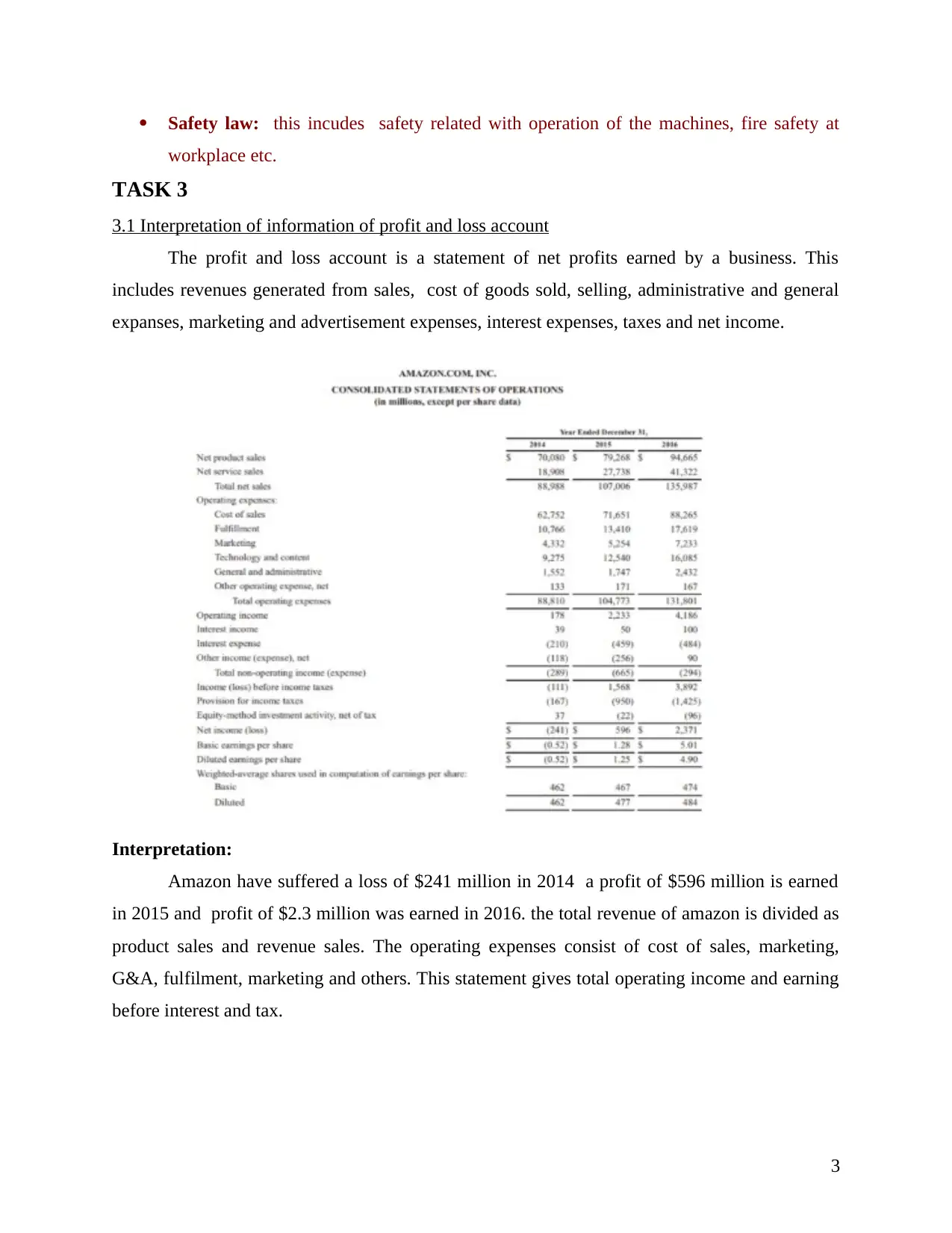
Safety law: this incudes safety related with operation of the machines, fire safety at
workplace etc.
TASK 3
3.1 Interpretation of information of profit and loss account
The profit and loss account is a statement of net profits earned by a business. This
includes revenues generated from sales, cost of goods sold, selling, administrative and general
expanses, marketing and advertisement expenses, interest expenses, taxes and net income.
Interpretation:
Amazon have suffered a loss of $241 million in 2014 a profit of $596 million is earned
in 2015 and profit of $2.3 million was earned in 2016. the total revenue of amazon is divided as
product sales and revenue sales. The operating expenses consist of cost of sales, marketing,
G&A, fulfilment, marketing and others. This statement gives total operating income and earning
before interest and tax.
3
workplace etc.
TASK 3
3.1 Interpretation of information of profit and loss account
The profit and loss account is a statement of net profits earned by a business. This
includes revenues generated from sales, cost of goods sold, selling, administrative and general
expanses, marketing and advertisement expenses, interest expenses, taxes and net income.
Interpretation:
Amazon have suffered a loss of $241 million in 2014 a profit of $596 million is earned
in 2015 and profit of $2.3 million was earned in 2016. the total revenue of amazon is divided as
product sales and revenue sales. The operating expenses consist of cost of sales, marketing,
G&A, fulfilment, marketing and others. This statement gives total operating income and earning
before interest and tax.
3
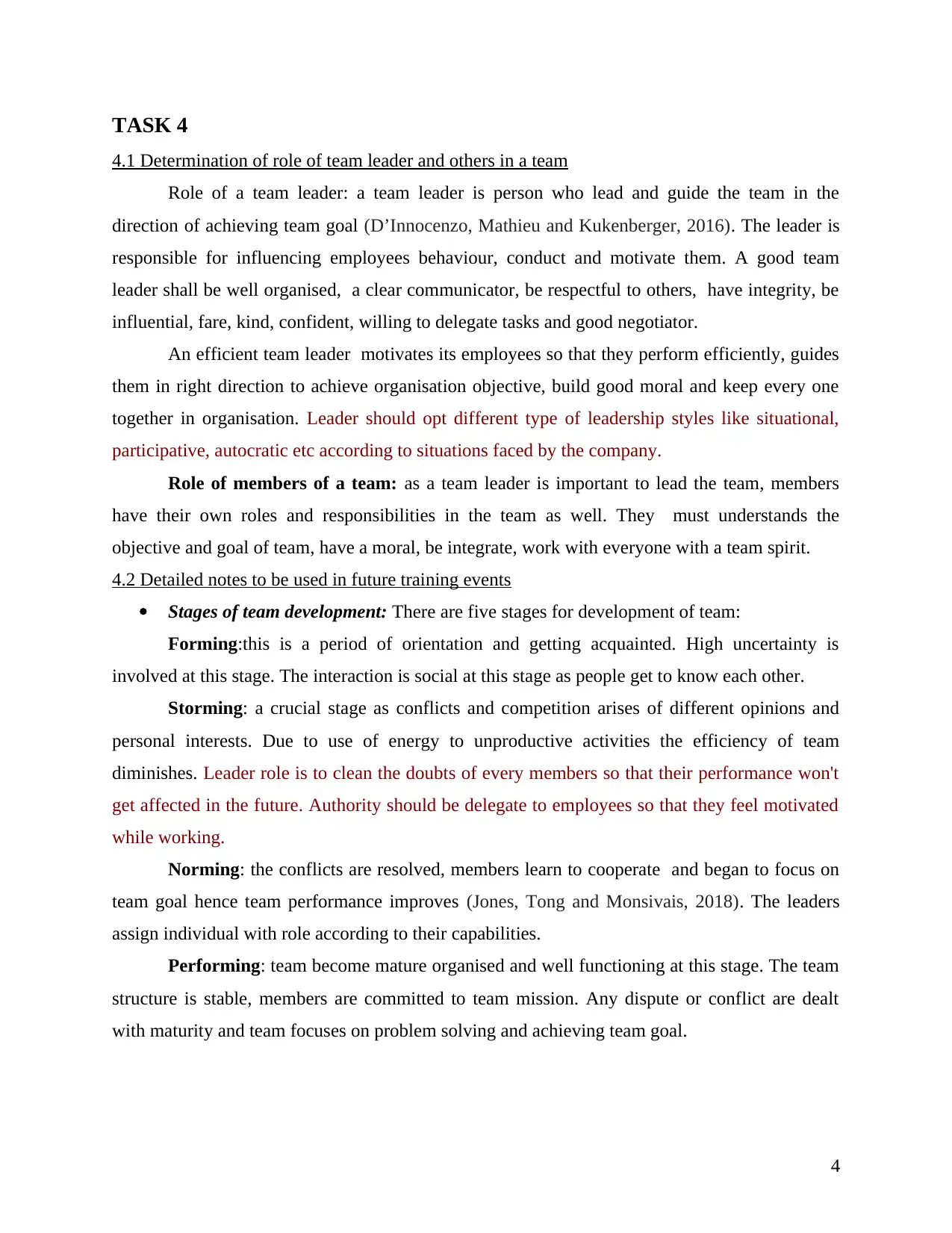
TASK 4
4.1 Determination of role of team leader and others in a team
Role of a team leader: a team leader is person who lead and guide the team in the
direction of achieving team goal (D’Innocenzo, Mathieu and Kukenberger, 2016). The leader is
responsible for influencing employees behaviour, conduct and motivate them. A good team
leader shall be well organised, a clear communicator, be respectful to others, have integrity, be
influential, fare, kind, confident, willing to delegate tasks and good negotiator.
An efficient team leader motivates its employees so that they perform efficiently, guides
them in right direction to achieve organisation objective, build good moral and keep every one
together in organisation. Leader should opt different type of leadership styles like situational,
participative, autocratic etc according to situations faced by the company.
Role of members of a team: as a team leader is important to lead the team, members
have their own roles and responsibilities in the team as well. They must understands the
objective and goal of team, have a moral, be integrate, work with everyone with a team spirit.
4.2 Detailed notes to be used in future training events
Stages of team development: There are five stages for development of team:
Forming:this is a period of orientation and getting acquainted. High uncertainty is
involved at this stage. The interaction is social at this stage as people get to know each other.
Storming: a crucial stage as conflicts and competition arises of different opinions and
personal interests. Due to use of energy to unproductive activities the efficiency of team
diminishes. Leader role is to clean the doubts of every members so that their performance won't
get affected in the future. Authority should be delegate to employees so that they feel motivated
while working.
Norming: the conflicts are resolved, members learn to cooperate and began to focus on
team goal hence team performance improves (Jones, Tong and Monsivais, 2018). The leaders
assign individual with role according to their capabilities.
Performing: team become mature organised and well functioning at this stage. The team
structure is stable, members are committed to team mission. Any dispute or conflict are dealt
with maturity and team focuses on problem solving and achieving team goal.
4
4.1 Determination of role of team leader and others in a team
Role of a team leader: a team leader is person who lead and guide the team in the
direction of achieving team goal (D’Innocenzo, Mathieu and Kukenberger, 2016). The leader is
responsible for influencing employees behaviour, conduct and motivate them. A good team
leader shall be well organised, a clear communicator, be respectful to others, have integrity, be
influential, fare, kind, confident, willing to delegate tasks and good negotiator.
An efficient team leader motivates its employees so that they perform efficiently, guides
them in right direction to achieve organisation objective, build good moral and keep every one
together in organisation. Leader should opt different type of leadership styles like situational,
participative, autocratic etc according to situations faced by the company.
Role of members of a team: as a team leader is important to lead the team, members
have their own roles and responsibilities in the team as well. They must understands the
objective and goal of team, have a moral, be integrate, work with everyone with a team spirit.
4.2 Detailed notes to be used in future training events
Stages of team development: There are five stages for development of team:
Forming:this is a period of orientation and getting acquainted. High uncertainty is
involved at this stage. The interaction is social at this stage as people get to know each other.
Storming: a crucial stage as conflicts and competition arises of different opinions and
personal interests. Due to use of energy to unproductive activities the efficiency of team
diminishes. Leader role is to clean the doubts of every members so that their performance won't
get affected in the future. Authority should be delegate to employees so that they feel motivated
while working.
Norming: the conflicts are resolved, members learn to cooperate and began to focus on
team goal hence team performance improves (Jones, Tong and Monsivais, 2018). The leaders
assign individual with role according to their capabilities.
Performing: team become mature organised and well functioning at this stage. The team
structure is stable, members are committed to team mission. Any dispute or conflict are dealt
with maturity and team focuses on problem solving and achieving team goal.
4
⊘ This is a preview!⊘
Do you want full access?
Subscribe today to unlock all pages.

Trusted by 1+ million students worldwide
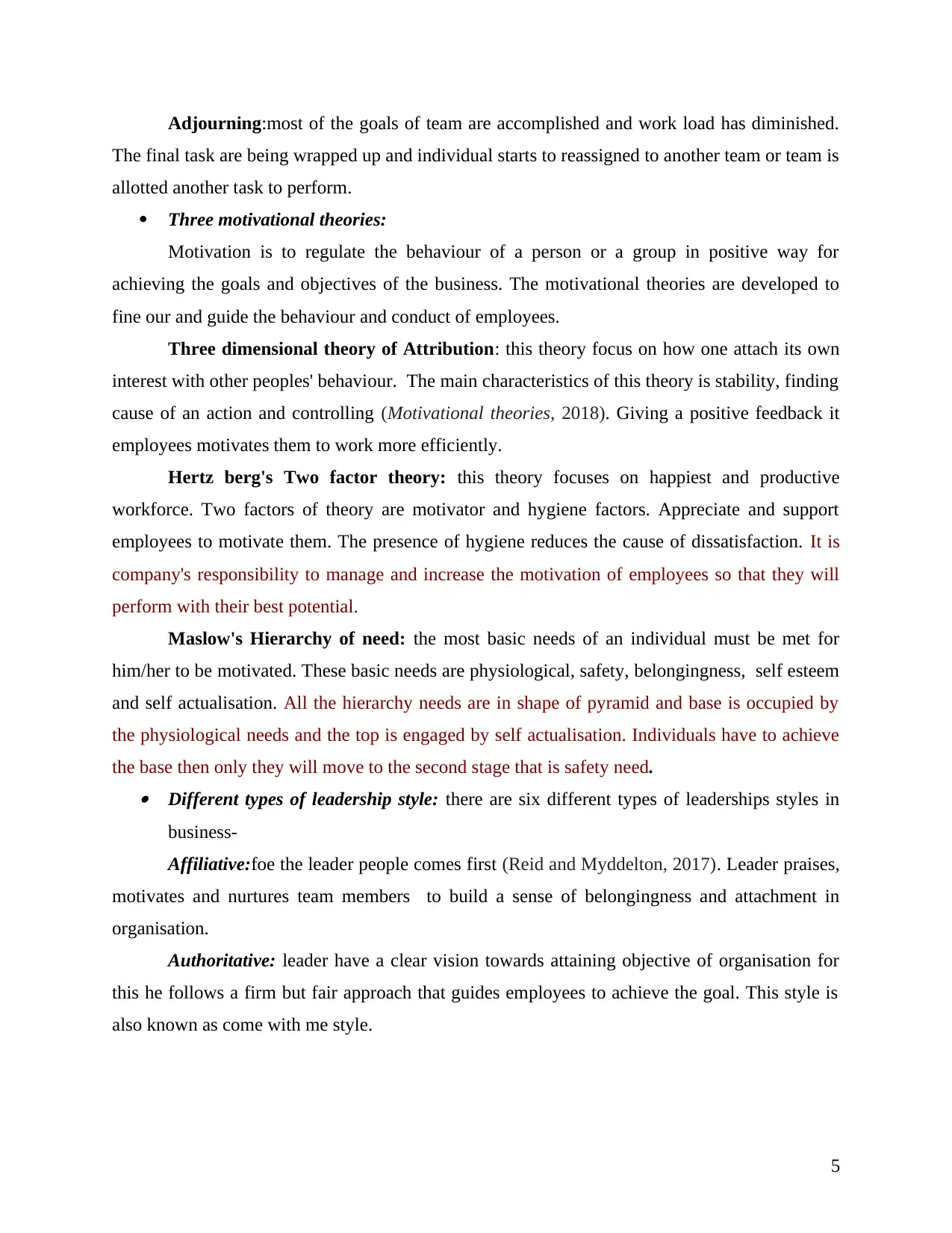
Adjourning:most of the goals of team are accomplished and work load has diminished.
The final task are being wrapped up and individual starts to reassigned to another team or team is
allotted another task to perform.
Three motivational theories:
Motivation is to regulate the behaviour of a person or a group in positive way for
achieving the goals and objectives of the business. The motivational theories are developed to
fine our and guide the behaviour and conduct of employees.
Three dimensional theory of Attribution: this theory focus on how one attach its own
interest with other peoples' behaviour. The main characteristics of this theory is stability, finding
cause of an action and controlling (Motivational theories, 2018). Giving a positive feedback it
employees motivates them to work more efficiently.
Hertz berg's Two factor theory: this theory focuses on happiest and productive
workforce. Two factors of theory are motivator and hygiene factors. Appreciate and support
employees to motivate them. The presence of hygiene reduces the cause of dissatisfaction. It is
company's responsibility to manage and increase the motivation of employees so that they will
perform with their best potential.
Maslow's Hierarchy of need: the most basic needs of an individual must be met for
him/her to be motivated. These basic needs are physiological, safety, belongingness, self esteem
and self actualisation. All the hierarchy needs are in shape of pyramid and base is occupied by
the physiological needs and the top is engaged by self actualisation. Individuals have to achieve
the base then only they will move to the second stage that is safety need. Different types of leadership style: there are six different types of leaderships styles in
business-
Affiliative:foe the leader people comes first (Reid and Myddelton, 2017). Leader praises,
motivates and nurtures team members to build a sense of belongingness and attachment in
organisation.
Authoritative: leader have a clear vision towards attaining objective of organisation for
this he follows a firm but fair approach that guides employees to achieve the goal. This style is
also known as come with me style.
5
The final task are being wrapped up and individual starts to reassigned to another team or team is
allotted another task to perform.
Three motivational theories:
Motivation is to regulate the behaviour of a person or a group in positive way for
achieving the goals and objectives of the business. The motivational theories are developed to
fine our and guide the behaviour and conduct of employees.
Three dimensional theory of Attribution: this theory focus on how one attach its own
interest with other peoples' behaviour. The main characteristics of this theory is stability, finding
cause of an action and controlling (Motivational theories, 2018). Giving a positive feedback it
employees motivates them to work more efficiently.
Hertz berg's Two factor theory: this theory focuses on happiest and productive
workforce. Two factors of theory are motivator and hygiene factors. Appreciate and support
employees to motivate them. The presence of hygiene reduces the cause of dissatisfaction. It is
company's responsibility to manage and increase the motivation of employees so that they will
perform with their best potential.
Maslow's Hierarchy of need: the most basic needs of an individual must be met for
him/her to be motivated. These basic needs are physiological, safety, belongingness, self esteem
and self actualisation. All the hierarchy needs are in shape of pyramid and base is occupied by
the physiological needs and the top is engaged by self actualisation. Individuals have to achieve
the base then only they will move to the second stage that is safety need. Different types of leadership style: there are six different types of leaderships styles in
business-
Affiliative:foe the leader people comes first (Reid and Myddelton, 2017). Leader praises,
motivates and nurtures team members to build a sense of belongingness and attachment in
organisation.
Authoritative: leader have a clear vision towards attaining objective of organisation for
this he follows a firm but fair approach that guides employees to achieve the goal. This style is
also known as come with me style.
5
Paraphrase This Document
Need a fresh take? Get an instant paraphrase of this document with our AI Paraphraser
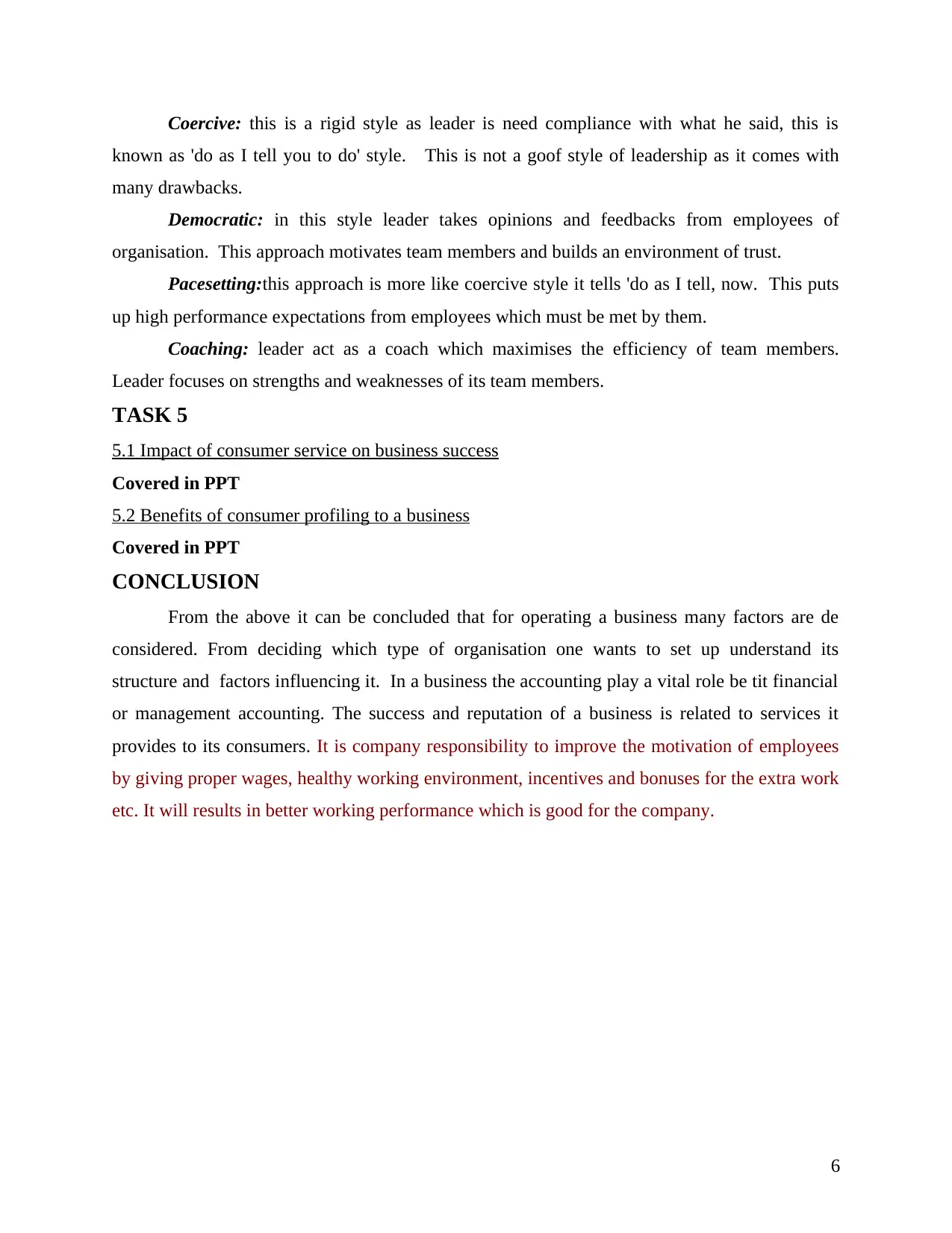
Coercive: this is a rigid style as leader is need compliance with what he said, this is
known as 'do as I tell you to do' style. This is not a goof style of leadership as it comes with
many drawbacks.
Democratic: in this style leader takes opinions and feedbacks from employees of
organisation. This approach motivates team members and builds an environment of trust.
Pacesetting:this approach is more like coercive style it tells 'do as I tell, now. This puts
up high performance expectations from employees which must be met by them.
Coaching: leader act as a coach which maximises the efficiency of team members.
Leader focuses on strengths and weaknesses of its team members.
TASK 5
5.1 Impact of consumer service on business success
Covered in PPT
5.2 Benefits of consumer profiling to a business
Covered in PPT
CONCLUSION
From the above it can be concluded that for operating a business many factors are de
considered. From deciding which type of organisation one wants to set up understand its
structure and factors influencing it. In a business the accounting play a vital role be tit financial
or management accounting. The success and reputation of a business is related to services it
provides to its consumers. It is company responsibility to improve the motivation of employees
by giving proper wages, healthy working environment, incentives and bonuses for the extra work
etc. It will results in better working performance which is good for the company.
6
known as 'do as I tell you to do' style. This is not a goof style of leadership as it comes with
many drawbacks.
Democratic: in this style leader takes opinions and feedbacks from employees of
organisation. This approach motivates team members and builds an environment of trust.
Pacesetting:this approach is more like coercive style it tells 'do as I tell, now. This puts
up high performance expectations from employees which must be met by them.
Coaching: leader act as a coach which maximises the efficiency of team members.
Leader focuses on strengths and weaknesses of its team members.
TASK 5
5.1 Impact of consumer service on business success
Covered in PPT
5.2 Benefits of consumer profiling to a business
Covered in PPT
CONCLUSION
From the above it can be concluded that for operating a business many factors are de
considered. From deciding which type of organisation one wants to set up understand its
structure and factors influencing it. In a business the accounting play a vital role be tit financial
or management accounting. The success and reputation of a business is related to services it
provides to its consumers. It is company responsibility to improve the motivation of employees
by giving proper wages, healthy working environment, incentives and bonuses for the extra work
etc. It will results in better working performance which is good for the company.
6
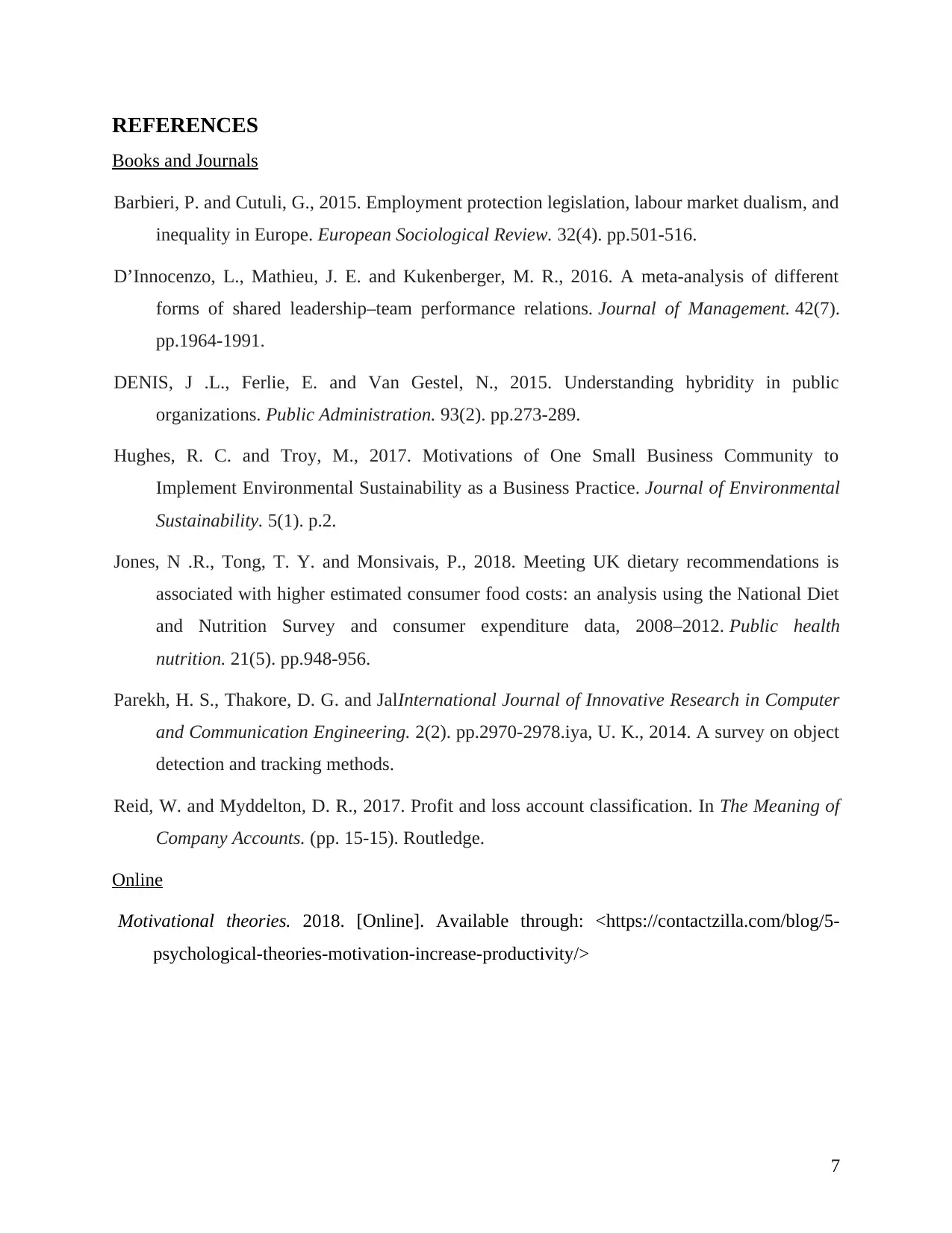
REFERENCES
Books and Journals
Barbieri, P. and Cutuli, G., 2015. Employment protection legislation, labour market dualism, and
inequality in Europe. European Sociological Review. 32(4). pp.501-516.
D’Innocenzo, L., Mathieu, J. E. and Kukenberger, M. R., 2016. A meta-analysis of different
forms of shared leadership–team performance relations. Journal of Management. 42(7).
pp.1964-1991.
DENIS, J .L., Ferlie, E. and Van Gestel, N., 2015. Understanding hybridity in public
organizations. Public Administration. 93(2). pp.273-289.
Hughes, R. C. and Troy, M., 2017. Motivations of One Small Business Community to
Implement Environmental Sustainability as a Business Practice. Journal of Environmental
Sustainability. 5(1). p.2.
Jones, N .R., Tong, T. Y. and Monsivais, P., 2018. Meeting UK dietary recommendations is
associated with higher estimated consumer food costs: an analysis using the National Diet
and Nutrition Survey and consumer expenditure data, 2008–2012. Public health
nutrition. 21(5). pp.948-956.
Parekh, H. S., Thakore, D. G. and JalInternational Journal of Innovative Research in Computer
and Communication Engineering. 2(2). pp.2970-2978.iya, U. K., 2014. A survey on object
detection and tracking methods.
Reid, W. and Myddelton, D. R., 2017. Profit and loss account classification. In The Meaning of
Company Accounts. (pp. 15-15). Routledge.
Online
Motivational theories. 2018. [Online]. Available through: <https://contactzilla.com/blog/5-
psychological-theories-motivation-increase-productivity/>
7
Books and Journals
Barbieri, P. and Cutuli, G., 2015. Employment protection legislation, labour market dualism, and
inequality in Europe. European Sociological Review. 32(4). pp.501-516.
D’Innocenzo, L., Mathieu, J. E. and Kukenberger, M. R., 2016. A meta-analysis of different
forms of shared leadership–team performance relations. Journal of Management. 42(7).
pp.1964-1991.
DENIS, J .L., Ferlie, E. and Van Gestel, N., 2015. Understanding hybridity in public
organizations. Public Administration. 93(2). pp.273-289.
Hughes, R. C. and Troy, M., 2017. Motivations of One Small Business Community to
Implement Environmental Sustainability as a Business Practice. Journal of Environmental
Sustainability. 5(1). p.2.
Jones, N .R., Tong, T. Y. and Monsivais, P., 2018. Meeting UK dietary recommendations is
associated with higher estimated consumer food costs: an analysis using the National Diet
and Nutrition Survey and consumer expenditure data, 2008–2012. Public health
nutrition. 21(5). pp.948-956.
Parekh, H. S., Thakore, D. G. and JalInternational Journal of Innovative Research in Computer
and Communication Engineering. 2(2). pp.2970-2978.iya, U. K., 2014. A survey on object
detection and tracking methods.
Reid, W. and Myddelton, D. R., 2017. Profit and loss account classification. In The Meaning of
Company Accounts. (pp. 15-15). Routledge.
Online
Motivational theories. 2018. [Online]. Available through: <https://contactzilla.com/blog/5-
psychological-theories-motivation-increase-productivity/>
7
⊘ This is a preview!⊘
Do you want full access?
Subscribe today to unlock all pages.

Trusted by 1+ million students worldwide
1 out of 9
Related Documents
Your All-in-One AI-Powered Toolkit for Academic Success.
+13062052269
info@desklib.com
Available 24*7 on WhatsApp / Email
![[object Object]](/_next/static/media/star-bottom.7253800d.svg)
Unlock your academic potential
Copyright © 2020–2025 A2Z Services. All Rights Reserved. Developed and managed by ZUCOL.





